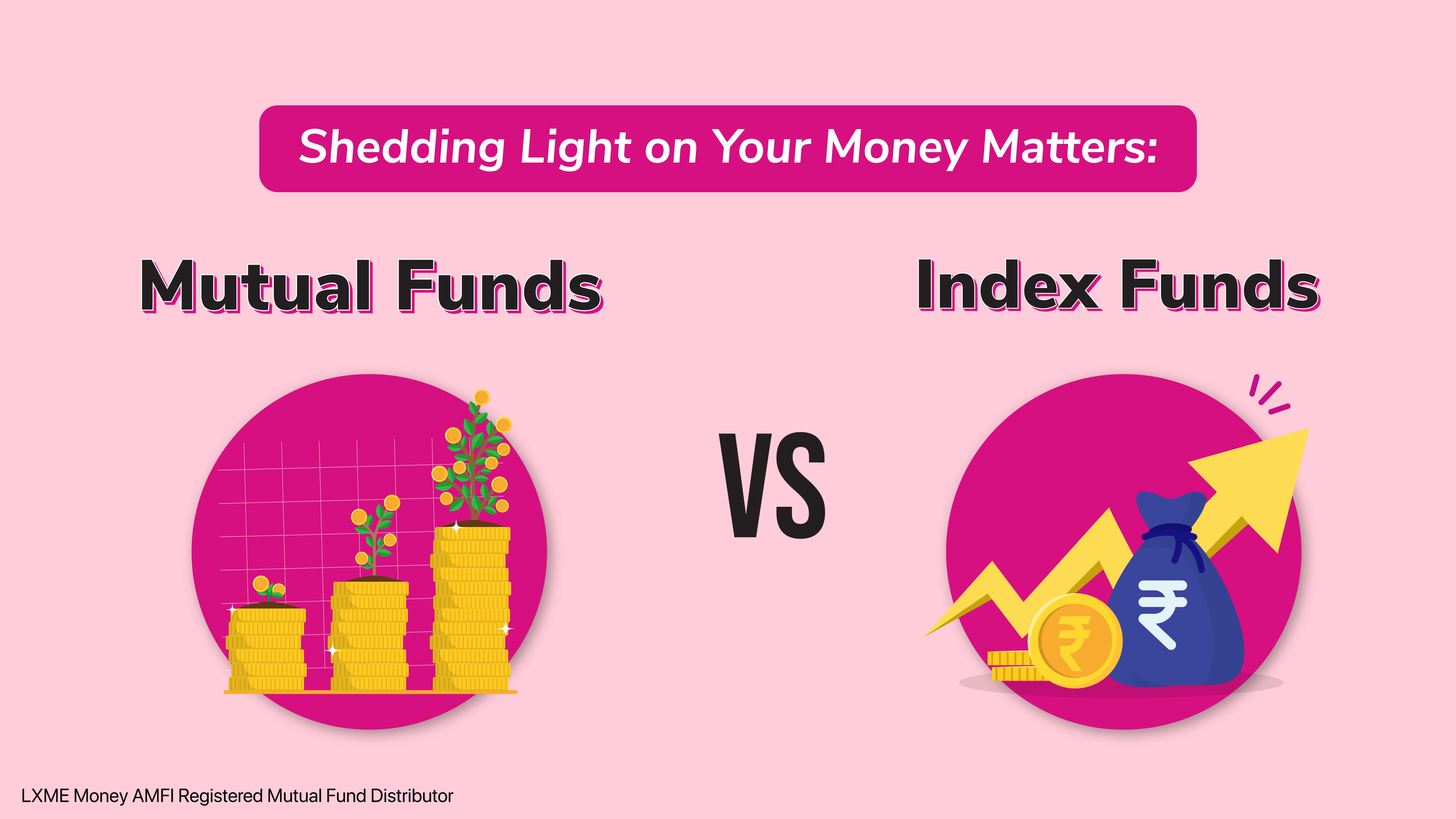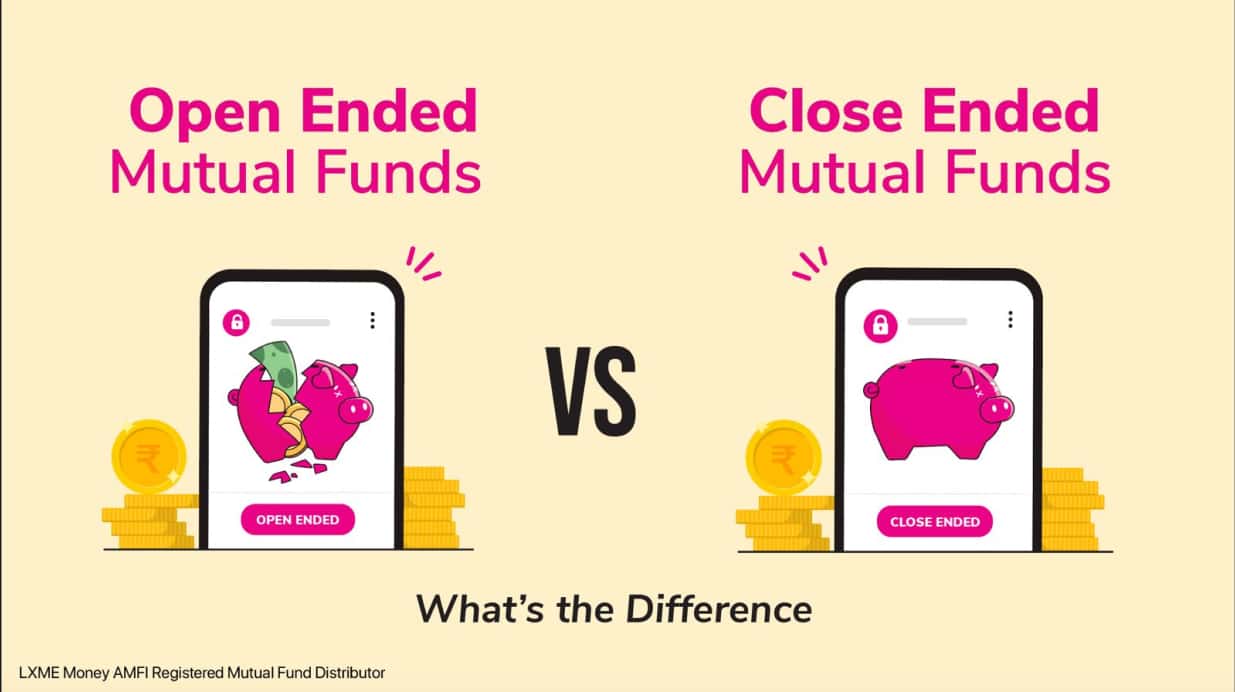Are you Surprised to know that there are different types of mutual funds? Confused about the difference between them? And wondering which one to invest in? Well, let us explain! Mutual funds are of two types: open ended and closed ended funds. As you read on, we’ll discuss the difference between open ended and closed ended mutual funds and explain which one is suited for you as a woman investor.
What are Open Ended Mutual Funds?
Open Ended mutual funds are those funds that can be bought or sold at any time. They don’t have a defined maturity period and there are no restrictions on how many units you can purchase and when you can sell them.
Features –
- Units are bought directly by investors. They are not traded publicly.
- Can be redeemed on demand at their NAV (Net Asset Value).
- High Liquidity
Check out the ‘invest’ tab and explore LXME’s goal-based portfolios offering open-ended mutual funds!
Types of Open-Ended Mutual Fund & How to Invest in them
Open-Ended Mutual Funds can be of different types, such as Equity MF, Debt MF, Hybrid MF and many more. Here’s an example of how to invest in them.
Kiara wants to invest her savings in Debt open ended mutual funds.
She chooses LXME’s Rs. 100 Debt Fund and invests Rs. 1000 through SIP. One year later, she faces an urgent need for funds and decides to withdraw her investments. As she has been investing in an open-ended fund, she is able to do this easily and quickly.
What are Close Ended Mutual Funds?
Close Ended mutual funds are those funds that have a fixed maturity period. They cannot be redeemed before a specified date, however similar to stocks, they can be traded on the stock exchange.
Features –
- Units are limited and can only be bought directly during the NFO (New Fund Offer). Afterwards, they are traded on the stock exchange.
- Traded at the fund’s current market price, which is determined by demand and supply of the fund. As a result, this price can be higher or lower than the NAV of the fund
- Low Liquidity as compared to open ended funds
Examples of Close Ended Funds & How to Invest in them
There are two types of Close Ended Funds: equity close-ended MF and debt close-ended MF. So, how can you invest in them? Let’s understand through an example.
Fund House ABC introduces a close-ended debt fund with a maturity of 5 years through a process called New Fund Offer (NFO). Jaya decides to purchase some units of this fund. Once the NFO ends, Jaya cannot sell these units to the fund house directly and redeem her investments for the next 5 years. However, she can trade them on the stock market.
Open ended vs Close ended mutual fund
| PARAMETERS | OPEN ENDED MF | CLOSE ENDED MF |
| Meaning | Those mutual funds that are issued continuously and can be redeemed on demand | Those mutual funds that are issued only during NFO (New Fund Offer) and have a predetermined maturity period |
| Maturity | No maturity period | Fixed Maturity Period, typically 3-5 years |
| Trading | Can be bought directly | Traded on the stock exchange |
| Investment Method | SIP or Lump sum | Only Lump Sum |
| Price | Price is determined by the NAV of the fund | Trading price is determined by forces of demand and supply, and can differ from NAV |
| Record | Past performance of a fund can be analyzed | No records on past performance of the fund |
| Tax Benefits | ELSS offers tax deductions up to Rs. 1.5 Lakhs under Section 80C | Doesn’t offer any tax benefits |
What are the advantages of Open-ended Mutual Funds?
You can buy and redeem your investments whenever needed
Open ended MF offer liquidity and you have the freedom to buy and sell your units whenever required. This is not true for close ended funds.
You can invest through SIP or Lumpsum
Unlike close ended MFs, here women can invest in easy periodic intervals through SIP. Both SIP and Lump sum investment options are available.
You have access to past performance record
Women investors can review and analyze the past performance of the funds and the returns it has been generating before making an investment decision.
You can avail tax benefits
Investments in ELSS, which are open ended tax saving MFs, offer tax benefits up to Rs. 1.5 lakhs under Sec 80C.
Open ended vs. close ended mutual fund: which is suitable for a woman investor?
It is better for a woman to invest in an open-ended mutual fund. This is because close-ended mutual funds cannot be bought or sold freely, they do not have an option for SIP investment, there is no availability of past performance of the fund and it has historically proven to perform poorly compared to open ended MFs.
To sum up, the difference between open ended and closed ended funds lies in the flexibility with which you can buy and sell them. Open ended funds give you more freedom when compared to close ended funds and some funds may even provide tax benefits.
You can start investing in open-ended funds via LXME portfolios! We have spent 1400+ hours curating the best-suited mutual funds portfolios out of the 2500+ schemes available that aim to help you achieve your financial goals.
FAQ’s
What is the difference between open ended and closed-end mutual funds?
Open ended mutual funds are issued continuously and can be redeemed on demand. Close ended mutual funds are issued only during NFO (New Fund Offer) and have a predetermined maturity period.
Is it good to invest in closed-end mutual fund?
It may not be suitable for everyone to invest in close ended mutual fund schemes as they have a fixed maturity period and have proven to perform poorly when compared to open ended mutual funds.
Can I sell close ended mutual fund?
You can only sell a close ended mutual fund at the end of its maturity period. However, they can be traded on the stock exchange.
Share this blog with your family and friends if you find it insightful!!
Download the LXME app for more such content!
New Investor? Request a Callback.
Fill in your details and we will guide you at every step
other blogs

Mutual Funds July 1, 2024
Shedding Light on Your Money Matters: Mutual Funds vs Index Funds
Conquering your financial goals takes knowledge and the right tools. At LXME, we empower women to take control of their money with online SIP investments. Today, we’ll delve into the world of mutual funds and index funds, two popular investment options. Understanding the difference between mutual fund and index fund will equip you to make … Shedding Light on Your Money Matters: Mutual Funds vs Index Funds

Mutual Funds
Conquer Your Future: Best SIP Plans for 30 Years and Building Financial Freedom with LXME
At LXME, we empower women to take control of their finances and achieve financial freedom. We understand the unique challenges women face when it comes to money matters, and that’s why we’ve built a safe and supportive investment platform designed exclusively catering to investment for women. But financial freedom doesn’t happen overnight, it requires a … Conquer Your Future: Best SIP Plans for 30 Years and Building Financial Freedom with LXME

Money Hacks Mutual Funds June 27, 2024
Navigating the Best Time to Buy Shares for Long-Term Growth
In the dynamic world of stock markets, strategic timing can be a game-changer for long-term investors. Our comprehensive blog, “Trying to Time Investments? Here Are Some Tips,” available on LXME, offers valuable insights into mastering the art of timing in stock investments. Uncover tips and strategies to identify the opportune moments to buy shares for … Navigating the Best Time to Buy Shares for Long-Term Growth









